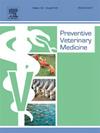A salmon lice prediction model
IF 2.2
2区 农林科学
Q1 VETERINARY SCIENCES
引用次数: 0
Abstract
Salmon lice (Lepeophtheirus salmonis) are parasites on salmonid fish and a density-dependent constraint to the sustainable farming of salmonids in open net pens. To control the parasites, fish farmers in Norway are required to count the number of salmon lice in different developmental stages on a subset of the fish each week. Furthermore, they must ensure that the number of adult female lice per fish does not increase beyond a specified threshold level. Here we present a model that may assist farmers in the salmon lice management. The model can predict the numbers of salmon lice in different developmental stages in each cage in a farm one to two weeks ahead. Input variables are current-week lice counts, a lice infestation pressure index, sea temperature, mean weight of the fish and presence or absence of wrasses (family Labridae) as cleaner fish. Count data for three parasitic stage groups (adult females, other motiles and sessile) are analysed jointly in one statistical model. The model predicted a large part of the variance, e.g. 50 % of the farm-level variance in adult female lice two weeks ahead. At farm-level, but not at cage-level, the numbers of other motile and sessile lice were, however, similarly well predicted by assuming “next week is the same as this week”. The model also quantifies uncertainty and shows what range of outcomes is likely given the observations to that date. By using this model as decision support, fish farmers may more accurately assess the risk of exceeding lice limits.
一个鲑鱼虱预测模型。
鲑虱(Lepeophtheirus salmonis)是鲑科鱼类的寄生虫,是开放式网栏中可持续养殖鲑科鱼类的密度依赖性制约因素。为了控制这种寄生虫,挪威的养鱼户被要求每周统计不同发育阶段的鲑鱼虱的数量。此外,他们必须确保每条鱼的成年雌虱数量不超过规定的阈值水平。在这里,我们提出了一个模型,可以帮助农民在鲑鱼虱管理。该模型可以提前一到两周预测养殖场每个笼中处于不同发育阶段的鲑鱼虱的数量。输入变量为当周的虱子数量、虱子侵扰压力指数、海水温度、鱼的平均体重以及作为清洁鱼的濑鱼(濑鱼科)的存在与否。在一个统计模型中,对三个寄生阶段组(成年雌性、其他活动体和无梗体)的计数数据进行了联合分析。该模型预测了很大一部分方差,例如,成年雌性虱子提前两周的农场水平方差的50% %。然而,在农场水平,而不是笼子水平,其他活动和不动的虱子的数量同样可以通过假设“下周与本周相同”来预测。该模型还量化了不确定性,并显示了根据该日期的观测结果可能出现的结果范围。通过使用该模型作为决策支持,养鱼户可以更准确地评估超过虱限的风险。
本文章由计算机程序翻译,如有差异,请以英文原文为准。
求助全文
约1分钟内获得全文
求助全文
来源期刊

Preventive veterinary medicine
农林科学-兽医学
CiteScore
5.60
自引率
7.70%
发文量
184
审稿时长
3 months
期刊介绍:
Preventive Veterinary Medicine is one of the leading international resources for scientific reports on animal health programs and preventive veterinary medicine. The journal follows the guidelines for standardizing and strengthening the reporting of biomedical research which are available from the CONSORT, MOOSE, PRISMA, REFLECT, STARD, and STROBE statements. The journal focuses on:
Epidemiology of health events relevant to domestic and wild animals;
Economic impacts of epidemic and endemic animal and zoonotic diseases;
Latest methods and approaches in veterinary epidemiology;
Disease and infection control or eradication measures;
The "One Health" concept and the relationships between veterinary medicine, human health, animal-production systems, and the environment;
Development of new techniques in surveillance systems and diagnosis;
Evaluation and control of diseases in animal populations.
 求助内容:
求助内容: 应助结果提醒方式:
应助结果提醒方式:


